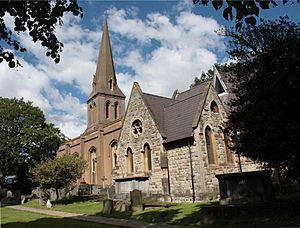St Leonard's Church, Streatham facts for kids
Quick facts for kids St Leonard’s Church, Streatham |
|
|---|---|
 |
|
| Location | Tooting Bec Gardens, Streatham, London SW16 1HS |
| Country | United Kingdom |
| Denomination | Church of England |
| Churchmanship | Modern Catholic |
| Administration | |
| Parish | St Leonard, Streatham |
| Deanery | Lambeth South Deanery |
| Archdeaconry | Archdeaconry of Lambeth |
| Diocese | Diocese of Southwark |
| Province | Province of Canterbury |
St Leonard's Church is a special Church of England building in London. It is located in an area called Streatham, in the London Borough of Lambeth. This church is a very old and important building. It is officially known as a Grade II listed building. This means it is protected because of its history and unique architecture. You can find it easily on the west side of Streatham High Road.
Contents
What is a Parish?
A parish is like a local area that a church serves. It's a community where people live and go to a specific church. The area around St Leonard's Church has been a parish for a very long time. It was even mentioned in a famous old book called the Domesday Book. This book was written almost a thousand years ago!
Over many years, more and more people moved to Streatham. Because the population grew so much, the original parish of St Leonard's became too big. So, parts of it were used to create new, smaller parishes. This helped more churches serve their local communities better. For example, new parishes like St Peter, Streatham, and St Mary, Balham, were formed.
The Church Building's History
The oldest part of St Leonard's Church is the bottom of its tower. This part was built way back in the 1300s! Inside the church, you can find other old items. There is a font from the 1400s. A font is a special basin used for baptisms. You can also see a damaged statue of a knight from the 1300s. There are also old brass plaques and monuments.
Most of the church, except for the tower, was rebuilt in 1830 and 1831. This work was done following plans by an architect named Joseph T. Parkinson. Later, in 1841, lightning struck the church's spire. The spire is the tall, pointed top of the tower. So, the top of the tower and the spire had to be rebuilt again.
In 1863, a new stone chancel was added. The chancel is the part of the church where the altar is. This was designed by William Dyce. Another architect, Benjamin Ferrey, finished the work. More changes were made to the church in 1877. There is a special plaque inside the church that remembers William Dyce.
Fire and Restoration
A big fire badly damaged the church on May 5, 1975. The inside of the church was almost completely destroyed. After the fire, the church was carefully restored. The Douglas Feast Partnership led this restoration work.
During the restoration, some new things were added. A staircase was built to reach the gallery. A gallery is an upper floor inside the church. A new mezzanine floor was also added. New seats were put in, and a new organ was installed. The floor was paved with stone, and some old grave markers were included in it. A special area called the Chapel of Unity was created. New windows were also added to the nave and chancel.
Churchyard and Monuments
The churchyard around St Leonard's is full of old monuments. These are like memorials for people who have passed away. Four of these tombs are also listed buildings, just like the church itself. They remember:
- George Abell, who died in 1826.
- Joseph Hay, who died in 1805.
- Lt. Col. William Boyce, who died in 1808.
- Thomas Helps, who died in 1842, and his family.
Looking at History Differently
Sometimes, we look at history and famous people from the past in new ways. In 2020, Lambeth Council asked for a review. They wanted to find places in Lambeth that had links to difficult parts of history, like colonialism. Colonialism is when one country takes control of another country.
This review looked at a memorial inside St Leonard's Church. It is a memorial to John Massingberd. He was a treasurer for the East India Company. This company played a big role in British colonialism. The review found that this memorial had a clear link to these historical issues. This shows how we continue to learn about and discuss our past.

